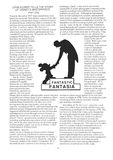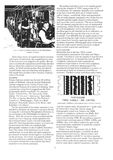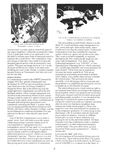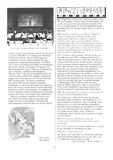



Towards the end of 1937 when sound films were barely ten years old, Walt Disney conceived the idea of making a cartoon short using a well known piece of classical music which lent itself to animation. He had been doing a similar thing for some years with his Silly Symphony series. The Sorcerer's Apprentice was the musical item he selected, a piece which had just been publicly performed and was considered a great success. Written by the French composer Paul Dukas, who had taken his theme from a two thousand year old fable, the story concerns an apprentice magician who dons his master's hat and pronounces magic words to give a broom the task of fetching water from a well. But he is unable to stop the broom and takes an axe to it. The broom splits into two halves and even more water is fetched for the well. Disney's idea was to interpret Dukas' music pictorially using Mickey Mouse as the Apprentice. Just by chance Disney met the legendary Polish conductor Leopold Stokowski in a Hollywood restaurant, and after Disney had explained his idea Stokowski agreed to co-operate. He convinced Disney that an ordinary photographic sound track had an insufficient volume range to give a dramatic effect. Stokowski had already had some experience of this with the Diana Durbin film 100 Men and a Girl. having spent the previous twenty years giving concerts, recording for RCA, and experimenting with different seating arrangements for the musicians, he suggested splitting the orchestra up into sections and reproducing the music through several channels to spread the sound over a wide area - as in an actual concert. Disney agreed and the problem of creating a recording and reproducing system which would do this, and at the same time increase the dynamic range of photographic sound, was given to Disney's chief sound engineer William Garity. Recording begins Garity set out to design an effective multi-channel system, something which had not been attempted previously. He was helped considerably by Disney's chief re-recording mixer J.N.A. Hawkins, and H.M. Tremaine (author of the Audio Cyclopedia). RCA also took an active interest in developing the new techniques. Garity's idea was to use several standard RCA mono photographic channels for the original recordings with a different section of the orchestra on each one. Although he had already built several reproduction systems, and explored many more on paper, at this stage he did not know what his final equipment combination would be. He decided to record everything in push-pull, which was the 'state-of-the-art' at that time. It had been found that push-pull systems cancelled out a lot of the photographic distortion caused by image spread, as well as most of the noise due to film joins. Class A and Class B systems were in use, obtained by placing different shaped masks in the optical system. Both types were used for original recordings, and required a special reproducer with two photocells connected out of phase. Class B was preferred by some studios since it did not require and noise reduction shutters, and Republic Studios had already converted all their recorders. Garity chose to use Class A, mainly because one half of the track could be replayed on a standard reproducer not equipped for push-pull. RCA also fitted ultra-violet filters to restrict the exposure of the negative to the surface of the emulsion in a further attempt to reduce image spread. Even with film stocks available in 1938, Garity found that he could record up to 9kHz which coincided with the galvanometer resonance. Recording of The Sorcerer's Apprentice took place over a three hour session with 84 musicians, commencing at midnight on 9th January 1938. This late hour was Stokowski's idea as he though that the musicians might be more alert! A production stage at Pathe's Culver City Studio was altered acoustically for the occasion to increase the reverberation and a circular orchestra shell installed to Stokowski's instructions. This shell was divided into five sections with plywood partitions in an attempt to provide some acoustical separation between each section of the orchestra. Unfortunately it was found that low frequencies passed right through these partitions, whilst at the same time the musicians in each section complained that they could not hear each other properly. Nevertheless after some seating adjustments a satisfactory recording was finally made. After many hours of sound mixdown sessions and weeks of animation, the completed two reels of the Sorcerer were judged to be terrific. But the cost exceeded all expectations and Disney decided that no short film could ever recoup such a large outlay. So Walt and his brother Roy decided to record further musical selections and produce a full length film and that is how fantastic Fantasia came to be made. Scoring Disney had just settled into his new $3 million studio at Burbank, when he invited Stokowski and the composer/critic Deems Taylor (who introduced Fantasia on screen) to a meeting. After considering a long list of suggestions the final programme chosen was Bach, Toccata and Fugue; Tchaikovsky, The Nutcracker Suite; Dukas, The Sorcerer's Apprentice; Stravinsky, The Rite of Spring; Beethoven, The Pastoral Symphony; Moussorgsky, Night on a Bald Mountain; Ponchielli, Dance of the Hours; and Schubert's Ave Maria. For the remainder of the music sessions it was decided to abandon the Sorcerer's set up in favour of using the well known Philadelphia Orchestra in its own home at the Philadelphia Academy of Music. Here the acoustics were excellent and the musicians were enjoying a high reputation for their musical talent. Garity was still undecided about his final reproduction system, so to provide for maximum flexibility he installed eight photographic channels in the Academy basement. Since the inside of the building was of wood construction, no more than one spare magazine per channel of nitrate sound negative was allowed on the premises. So a truck was parked outside and converted into a mobile darkroom. Having witnessed a nitrate fire I can confirm that these measures were strictly necessary. Recording took place over a two month period during the summer of 1939, using a total of 33 microphones. Six separate channels were employed to record a close mic pick-up of violins violas, cellos, basses, woodwind, brass and percussion. The seventh channel contained a mix of the first six channels and the eighth channel a more distant pick-up of the entire orchestra. The mixer handling this last channel enjoyed the luxury of loudspeaker monitoring, whilst all the other mixers had to make do with headphones. Garity decided to use oscilloscopes on all channels as level indicators, as he thought that this was the best way to see any overload. Over 400,000 feet of sound negative was exposed during the eight weeks of music sessions and it must have become quite hot down in the Academy basement. Photographs taken at the time show the eight sound camera operators stripped down to their waistcoats and braces! Fantasound Remember that in the late 1930s sound entertainment consisted of AM radio and 78rpm records. You had to visit the cinema to hear the best sound reproduction. At around this time the Bell Telephone Laboratories had conducted an ambitious experiment to record a full symphony orchestra on to multitrack photographic film reproduced through three loudspeaker systems, in an attempt to make an orchestra sound like an orchestra. The Bell system used three audio tracks and one control track, all printed on a single strip of 35mm film. Since the volume range of photographic sound was found to be 50dB, whereas a symphony orchestra was 80dB, Bell used a compression and expansion system to restore the missing 30dB. Be recording a separate control track carrying tones of 250Hz, 630Hz and 1600Hz, they were able to adjust the gain of the record and replay amplifiers to match the original orchestral volume range. Disney was very impressed with the Bell demonstration and thought it would be an ideal release format for Fantasia. Messrs Garity and Hawkins, together with RCA, set about adapting the Bell system to their own needs. They decided to keep to three audio tracks and one control track, and the same three control frequencies. But the control track was only used to control the gain of the replay amplifiers, rather like an automatic fader. Class A push-pull tracks were used and it was decided to include some form of surround sound to enhance the overall effect. The sound prints were also unique in that they were made on a specially designed optical printer with an anamorphic lens system. This gave an image ration of 1 to 1 in the direction of film travel, whilst at the same time doubling the track width. Disney's system instantly became known as Fantasound, and only survived for the one film. Re-recording It is interesting to read in the SMPTE Journal for August 1941 how quickly Fantasound was developed. In 1939 several re-recording systems were tried out in the old Disney Studios in Hyperion Street. But in the following year the sound and music departments moved to the new Burbank studios, where enough equipment was installed in the re-recording theatre so that system changes could be made in a matter of minutes by means of a few patch cords. Many combinations of channels and loudspeaker placements were considered, including the Mark V system which was so complicated that the Musical Director (Ed Plumb), the Music editor (Stephen Csillag), and the mixers themselves could not remember from one rehearsal to the next what should come out of where! One of the first requirements was to make a sound 'move' back and forth across the screen whilst maintaining a constant volume level. It was found that by fading between two loudspeakers spaced 20 feet apart, it was possible to simulate a moving sound source. A special two circuit volume control was designed called a differential junction network, which was instantly christened a 'pan-pot'. This new device was also found to be extremely useful to provide constant level fades between a close and distant mic pick-up, thus giving an accurate control of reverberation. The re-recording system finally chosen was the Mark VI, which had three stage loudspeakers for left, centre and right, three audio tracks, and a fourth track carrying the control tones. Auditorium loudspeakers were also installed for surround sound, which was quite a novel idea at the time. They were switched in manually as required throughout the film, replacing the stage left and stage right loudspeakers. The 'brain' of the Fantasound equipment was 'TOGAD', a Tone Operated Gain Adjusting Device, which consisted of a variable gain amplifier and a tone generator for each channel. These were use as required to increase the replay sound level. This set up required ten re-recording mixers each with three rotary faders, and a further three mixers to handle the control tones. This proved to be rather unwieldy, so by designing a three circuit pan-pot the problem was simplified and allowed six mixers to handle up to 24 channels of sound. The re-recording process meant running eight to ten separate mono tracks according to the sequence being handled, which were panned and mixed into three audio channels and fed into three mono push-pull photographic recorders. It was decided at this stage that it would be far easier to record the composite control tone track as a separate operation after the main mix had been completed, thus making the fourth sound negative. These four negatives were then synchronised for printing on to the composite quad print. It is interesting to note that Disney's RCA recorders were all fitted with noise reduction shutters, whereas in 1940 the biased galvo system of noise reduction was gaining favour as the preferred method. All three channels were also combined to make a standard sound negative, so that normal married prints could be made. This provided a back-up track should the Fantasound equipment fail - which it seldom did. Fantasound rise and fall The development of Fantasound did not end with the first mix. There followed the Mark VII system which was the first to be built entirely by RCA at a cost of $100,000. It was identical to the Mark VI which was the first to be built entirely by RCA at a cost of $100,000. It was identical to the Mark VI used for the mix, but included improved control tone circuits which changed the tone-programme amplitude characteristic. The Mark VIII system consisted of the Mark VII rearranged physically and the second mix of Fantasia was done through this system. This set of equipment was eventually installed in the Broadway Theater, New York, for the World Premiere on 13th November 1940. The amplifier and power supply racks stretched for over 30 feet and used 400 vacuum tubes. The power amplifiers delivered 120 watts per channel, and each loudspeaker system contains eight low frequency units and a large cellular horn to which four high frequency drivers were attached. Two additional 50 watt amplifiers fed 22 small speakers mounted on the sides, back and ceiling of the auditorium. With re-recording completed Fantasia was now ready for release upon an unsuspecting public. In the next Newsletter I will describe what happened when the film was finally shown.